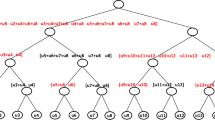Abstract
The implementation of reverse converter is one of the most important elements influencing the performance of a residue number system. In this research, we propose an efficient high-speed and low-area reverse converter for moduli set \(\{ 2^{4n} ,2^{2n} + 1,2^{n} + 1,2^{n} - 1\}\). Due to the form of the moduli set, we have implemented the proposed reverse converter using Chinese remainder theorem and dynamic range division technique, which have resulted in a simpler design, lower area consumption and higher conversion speed compared to previous studies. To have a fair comparison between the proposed reverse converter and the recently presented converters with similar moduli sets, we used Xilinx ISE 13.1 FPGA simulator to derive area and delay, which are measured to cover the various dynamic ranges up to 256 bit. The experimental results show that the proposed reverse converter achieves an average 20% area time saving compared to the recently presented converters for similar moduli set.

Similar content being viewed by others
References
A. Hiasat, An efficient reverse converter for the three-moduli set (2n+1−1, 2n, 2n–1). IEEE Trans. Circuits Syst. II Express Briefs 64, 962–966 (2017)
A. Hiasat, A residue-to-binary converter with an adjustable structure for an extended RNS three-moduli set. J. Circuits Syst. Comput. 28, 1950126 (2018)
A. Hiasat, A residue-To-binary converter for the extended four-moduli set {2n – 1, 2n + 1, 22n+1, 22n+P}. IEEE Trans. Very Large Scale Integr. Syst. 25, 2188–2192 (2017)
A. Hiasat, A reverse converter and sign detectors for an extended RNS five-moduli set. IEEE Trans. Circuits Syst. I Regul. Pap. 64, 111–121 (2017)
R.K. Jaiswal, R. Kumar, R.A. Mishra, Area efficient memoryless reverse converter for new four moduli set {2n−1, 2n − 1, 2n + 1, 22n+1−1}. J. Circuits Syst. Comput. 27, 1–13 (2018)
P.V.A. Mohan, Reverse conversion using core function, CRT and mixed radix conversion. Circuits Syst. Signal Process. 36, 2847–2874 (2017)
K. Navi, A.S. Molahosseini, M. Esmaeildoust, How to teach residue number system to computer scientists and engineers. IEEE Trans. Educ. 54, 156–163 (2011)
M.R. Noorimehr, M. Hosseinzadeh, R. Farshidi, High speed residue to binary converter for the new four-moduli set {22n, 2n + 1, 2n/2 + 1, 2n/2−1}. Arab. J. Sci. Eng. 39, 2887–2893 (2014)
M.R. Noorimehr, M. Hosseinzadeh, K. Navi, Efficient reverse converters for 4-moduli sets 22n–1–1,2n, 2n+1, 2n–1 and 22n–1–1, 22n–1, 2n+1, 2n–1 based on CRTs algorithm. Circuits Syst. Signal Process. 33, 3145–3163 (2014)
A. Omondi, B. Premkumar, Residue Number Systems: Theory and Implementation (Imperial College Press, London, 2007).
N. SalehiTabrizi, S. TaghipourEivazi, Designing efficient two-level reverse converters for moduli set { 2 2n+1- 1, 2 2n, 2 n- 1 }. Circuits Syst. Signal Process. 37, 4162–4180 (2018)
L. Sousa, R. Paludo, P. Martins, H. Pettenghi, Towards the integration of reverse converters into the RNS channels. IEEE Trans. Comput. 69, 342–348 (2020)
N.S. Szabó, R.I. Tanaka, Residue Arithmetic and Its Applications to Computer Technology (McGraw-Hill, 1967).
S. TaghipourEivazi, M. Hosseinzadeh, A. HabibizadNovin, Efficient RNS converter via two-part RNS. J. Circuits Syst. Comput. 24, 1550016 (2014)
M. Taghizadeghankalantari, S. TaghipourEivazi, Design of efficient reverse converters for residue number system. J. Circuits Syst. Comput. (2020). https://doi.org/10.1142/S0218126621501413
Y. Wang, X. Song, M. Aboulhamid, H. Shen, Adder based residue to binary number converters for (2n–1, 2n, 2n+1). IEEE Trans. Signal Process. 50, 1772–1779 (2002)
Author information
Authors and Affiliations
Corresponding author
Additional information
Publisher's Note
Springer Nature remains neutral with regard to jurisdictional claims in published maps and institutional affiliations.
Appendix
Appendix
The RTL of proposed converter for n = 3 is illustrated in Fig. 2.
The datasets generated during the current study are available from the corresponding author on reasonable request.
Rights and permissions
About this article
Cite this article
Akbari, A., Hosseinzadeh, M., TaghipourEivazi, S. et al. A New High-Speed, Low-Area Residue-to-Binary Converter For the Moduli Set \(\{ 2^{4n} ,2^{2n} + 1,2^{n} + 1,2^{n} - 1\}\) Based on CRT-1. Circuits Syst Signal Process 40, 5773–5786 (2021). https://doi.org/10.1007/s00034-021-01743-4
Received:
Revised:
Accepted:
Published:
Issue Date:
DOI: https://doi.org/10.1007/s00034-021-01743-4





